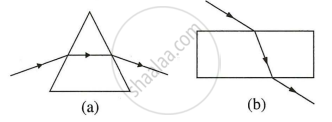Advertisements
Advertisements
प्रश्न
Explain the phenomenon of dispersion of white light through a glass prism, using suitable ray diagram.
उत्तर
Splitting of light into its constituent colors is referred to as dispersion. When a narrow beam of white light falls on a triangular glass prism, the light of different colors have different refractive indices in the glass. However, the speed of light is the same irrespective of its colors. Different refractive indices of different colors of light lead to their different bending pattern. This causes splitting of white light into light of seven colors called as VIBGYOR. V= violet, I= indigo, B=blue, G=green, Y= yellow, O=orange, R=red.

The light of red color bends the least on passing through the prism and appears at the top while violet color bends through the maximum angle and appears at the bottom.
APPEARS IN
संबंधित प्रश्न
Define the term angle of deviation.
The deviation produced by a prism is independent of the angle of incidence and is same for all the colours of light.
Diagrams (a) and (b) in figure below show the refraction of a ray of light of single colour through a prism and a parallel sided glass slab respectively.

- In each diagram, label the incident, refracted, emergent rays and the angle of deviation.
- In what way the direction of emergent ray in the two cases differ with respect to the incident ray? Explain your answer.
A ray of light incident at an angle of incidence i1 passes through an equilateral glass prism such that the refracted ray inside the prism is parallel to its base and emerges at an angle of emergence i2.
- How is the angle of emergence ‘i2’ related to the angle of incidence ‘i1’.
- What can you say about the angle of deviation in such a situation?
An object is viewed through a glass prism with its vertex pointing upwards. Draw a ray diagram to show the formation of its image as seen by the observer on the other side of the object.
A ray of light is normally incident on one face of an equilateral glass prism. Answer the following:
What will be the angle of incidence at the second face of the prism?
In refraction of light through a prism, the light ray ______.
Assertion: When a pencil is partly immersed in water and held obliquely to the surface, the pencil appears to bend at the water surface.
Reason: The apparent bending of the pencil is due to the refraction of light when it passes from water to air.
In an experiment to trace the path of a ray of light through a glass prism for different values of angle of incidence a student would find that the emergent ray:
Draw a ray diagram showing the dispersion through a prism when a narrow beam of white light is incident on one of its refracting surfaces. Also indicate the order of the colours of the spectrum obtained.
